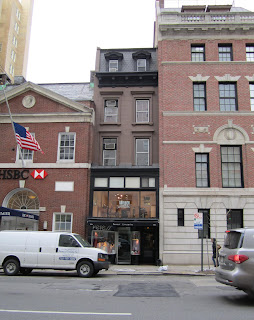
This is the west side of Second Avenue looking south from 10th Street. Unless you're impecunious and/or young and/or hang out in East Village bars, you might consider this a pretty anonymous - maybe even depressing - example of the urban streetscape. Look more closely, however, and you'll see a block of formerly fine houses interspersed with much later - 1890s to circa 1910 - tenements and apartment buildings.

Here's the east side of the Avenue between 12th and 13th Streets, showing what's actually an intact row of houses. Good lord, look what's happened to them.

See the sliver of house next to the Dentist's awning in the image above? This is a close-up of its surviving front door. The elegant engaged columns are highly characteristic of the Greek Revival style of the 1830s.

This poor old house has been "updated" by entombing the facade in corrugated metal sheets. Lots were wider when Second Avenue was developed - sometimes 25 to 30 feet wide. This house might have had a floor added to it. If so, it would originally have looked very much like the house illustrated below.

Picture this house, located on the east side of the Avenue between 9th and 10th Streets, with its elegant Greek door surround in unpainted brownstone, dark shutters on the windows, floor length parlor windows with iron balconies, a beautiful iron fence along the sidewalk, and possibly (though not necessarily) an attic pierced with delicate dormer windows, and you've got a pretty accurate idea of what the corrugated house across the street once looked like.
















































